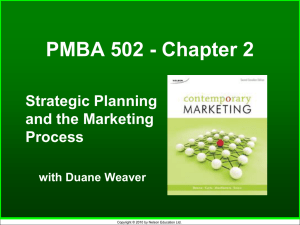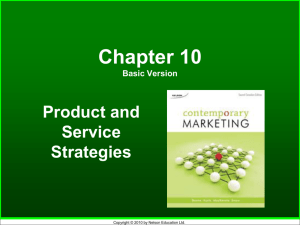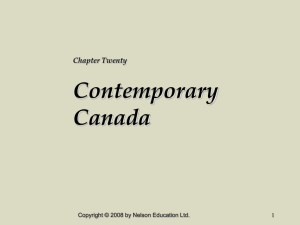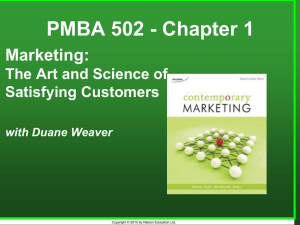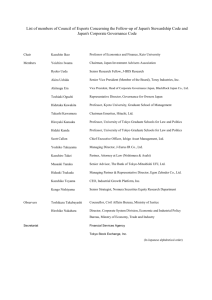Leadership in Organizations - Understanding Management, First
advertisement
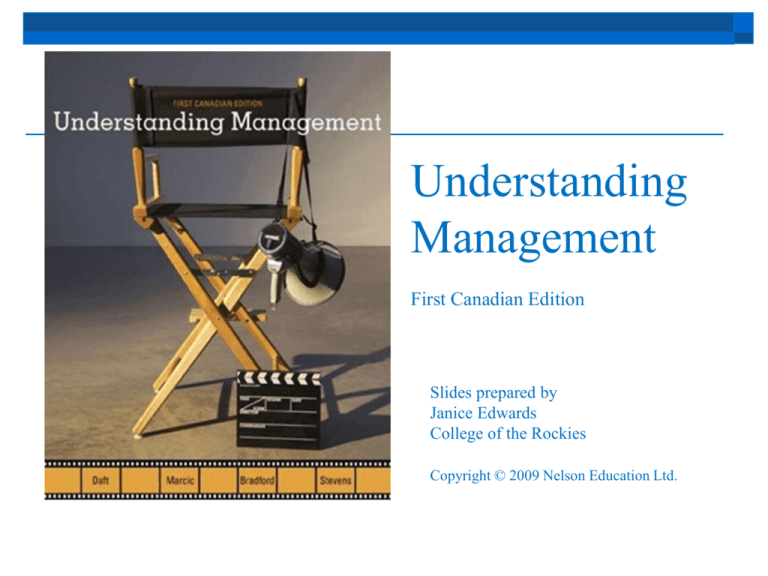
Understanding Management First Canadian Edition Slides prepared by Janice Edwards College of the Rockies Copyright © 2009 Nelson Education Ltd. Chapter 11 Leadership in Organizations Copyright © 2009 Nelson Education Ltd. 11-2 Learning Objectives 1. 2. 3. 4. 5. Define leadership and explain its importance for organizations. Identify personal characteristics associated with effective leaders. Describe the leader behaviours of initiating structure and consideration and when they should be used. Describe Hersey and Blanchard’s situational theory and its application to subordinate participation. Explain the path-goal model of leadership. Copyright © 2009 Nelson Education Ltd. 11-3 Learning Objectives (Cont’d.) 6. 7. 8. 9. Discuss how leadership fits the organizational situation and how organizational characteristics can substitute for leadership behaviours. Describe transformational leadership and when it should be used. Identify the five sources of leader power and how each causes different subordinate behaviour. Explain innovative approaches to leadership in a turbulent environment. Copyright © 2009 Nelson Education Ltd. 11-4 Leadership The ability to influence people toward the attainment of organizational goals. Copyright © 2009 Nelson Education Ltd. 11-5 Ex. 11.2 Personal Characteristics of Leaders Physical characteristics Work-related characteristics Social background Energy Achievement drive, desire to excel Education Physical stamina Conscientiousness in pursuit of goals Mobility Persistence against obstacles, tenacity Intelligence and ability Judgment, cognitive ability Knowledge Judgment, decisiveness Copyright © 2009 Nelson Education Ltd. Social characteristics Sociability, interpersonal skills Cooperativeness Ability to enlist cooperation Tact, diplomatic Personality Self-confidence Honesty and integrity Enthusiasm Desire to lead Independence 11-6 Behavioural Approaches that Help Determine Leadership Effectiveness Consideration: • Behaviour describing the extent to which the leader is: • Sensitive to subordinates • Respects their ideas and feelings, and • Establishes mutual trust Copyright © 2009 Nelson Education Ltd. 11-7 Behavioural Approaches that Help Determine Leadership Effectiveness (Cont’d.) Type of Leader: Behaviour that describes the extent to which the leader is: • Task oriented • Directs subordinates’ work activities toward goal attainment Copyright © 2009 Nelson Education Ltd. 11-8 Ex. 11.3 Copyright © 2009 Nelson Education Ltd. The Leadership Grid® Figure 11-9 Fiedler’s Contingency Theory Three Elements of Leadership Style: 1. Leader-member relations: refers to group atmosphere and members’ attitude toward and acceptance of the leader. 2. Task structure: refers to the extent to which tasks performed by the group are defined, involve specific procedures, and have clear, explicit goals. 3. Position power: is the extent to which the leader has formal authority over subordinates. Copyright © 2009 Nelson Education Ltd. 11-10 Fiedler’s Contingency Theory (Cont’d) Contingency Theory: • Task-oriented managers are more effective when the situation is highly favourable or unfavourable. • Relationship-oriented leaders are more effective in situations of moderate favourability. Copyright © 2009 Nelson Education Ltd. 11-11 Hersey and Blanchard’s Situational Theory A contingency approach to leadership that links the leader’s behavioural style with the task readiness of subordinates. Leader Style: • Telling • Selling • Participating • Delegating Copyright © 2009 Nelson Education Ltd. High task – low relationship High task – high relationship Low task – high relationship Low task – low relationship 11-12 Path-Goal Theory Contingency approach: The leader’s responsibility is to increase subordinates’ motivation to attain personal and organizational goals through: • Clarifying the paths to rewards. • Increasing the rewards that the subordinate values and desires. Copyright © 2009 Nelson Education Ltd. 11-13 Ex. 11.6 Leader Roles in the Path-Goal Model Copyright © 2009 Nelson Education Ltd. 11-14 Path-Goal Classification of Leader Behaviours Supportive leadership • Leader behaviour that shows concern for subordinates. • Open, friendly, and approachable. • Creates a team climate. • Treats subordinates as equals. Directive leadership • Tells subordinates exactly what they are supposed to do. • Planning, making schedules, setting performance goals, and behaviour standards. Copyright © 2009 Nelson Education Ltd. 11-15 Path-Goal Classification of Leader behaviours (Cont’d.) Participative leadership • Consults with his or her subordinates about decisions. Achievement-oriented leadership • Sets clear and challenging goals for subordinates. • behaviour stresses high-quality performance. Copyright © 2009 Nelson Education Ltd. 11-16 Situational Contingencies Two important situational contingencies in the Path-Goal theory: 1. The personal characteristics of group members: • • • • 2. Ability Skills Needs Motivations The work environment • • • Degree of task structure Nature of formal authority system Work group itself Copyright © 2009 Nelson Education Ltd. 11-17 Ex. 11.7 Path-Goal Situations and Preferred Leader behaviours SOURCE: Adapted from Gary A. Yukl, Leadership in Organizations (Englewood Cliffs, N.J.: Prentice-Hall 1981), 146-152. Copyright © 2009 Nelson Education Ltd. 11-18 Leading Change Transactional Leaders: • • • • • Clarify subordinates’ role and task requirements. Initiate structure. Provide appropriate rewards. Try to be considerate. Meet the social needs of subordinates. Copyright © 2009 Nelson Education Ltd. 11-19 Leading Change (Cont’d) Charismatic Leaders • • • • • Inspire and motivate people to do more than they would normally do. Put the interests of the organization first. Tend to be less predictable than transactional leaders. Create an atmosphere of change. May be obsessed by visionary ideas that excite, stimulate and drive other people to work hard . Copyright © 2009 Nelson Education Ltd. 11-20 Leading Change (Cont’d) Transformational Leaders • • • • Have a special ability to bring about innovation and change. Inspire followers to believe in the leader personally. Inspire followers to believe in their own potential. Able to lead changes in the organizations. Copyright © 2009 Nelson Education Ltd. 11-21 Forms of Position Power Legitimate Power •Power coming from a formal management position. Reward Power •Stems from the authority to bestow rewards on other people. Coercive Power •The authority to punish or recommend punishment. Copyright © 2009 Nelson Education Ltd. 11-22 Forms of Personal Power Expert Power: • leader’s special knowledge or skill regarding the tasks performed by followers. Referent Power: • personality characteristics that command subordinates’ identification, respect, and admiration so they wish to emulate the leader. Copyright © 2009 Nelson Education Ltd. 11-23
